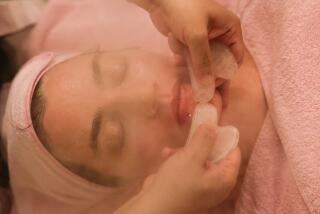BOTOX UNFURROWED
- Share via
YOU’VE seen them at the mall, in line at the grocery store, even on television. Their foreheads are crease-free islands of taut skin. They smile, yet their upper face stays frozen. An upturned mouth signals happiness, but the expression reveals nothing.
You wonder: Are they asking a question? Are they concerned? And then it registers: You’re looking at bad Botox.
In the worst circumstances, it’s called the “joker face” or the “Mr. Spock,” and it’s just one of the many facial follies -- drooping eye lids, asymmetrical eyebrows (or brows that slope too low and create a sleepy look) and the ever-feared “mask face” (an inability to squint, frown or maintain a facial expression) -- that has been immortalized in medical journals by aesthetic dermatologists and plastic surgeons as cases of when good Botox gets botched. And it’s become more conspicuous as Botox becomes more ubiquitous.
Twenty years ago, a handful of doctors began experimenting with the miracle protein for cosmetic purposes, and 20 years later, we’re well beyond worrying about whether or not injecting a bacterium, derived from the toxin botulism, is safe.
According to the American Society of Plastic Surgeons, more than 4 million Botox injections were performed in 2006 for about a million men and women who chose the minimally invasive and temporary treatment to diminish wrinkling and frown lines.
Now that the protocols for how and where to inject Botox have been established and tested by time, the conversation has shifted toward fine-tuning the technique, and it’s become clear that not all injectors (or patients) are the same.
The problem is this: Botox is no longer the luxurious domain of those with flush bank accounts and access to Beverly Hills dermatologists or plastic surgeons. Treatment can cost anywhere from $200 in the mall to $500 in the office per area injected. Thanks to an aggressive marketing campaign by Allergan, the Irvine-based company that manufactures the protein, along with its certified injection courses, Botox is available at the mall and at medi-spas and can be administered by nonaesthetic specialists: gynecologists, family practitioners, a variety of other medical professionals, as well as nonphysicians.
The result: a one-size-fits-all approach by nonspecialists who may not have intimate knowledge of facial anatomy. That shortcoming is complicated by the discovery that Botox diffuses throughout the muscles surrounding the injection point. Which is why Botox in the wrong hands may freeze the face in all the wrong places.
In fact, a 2002 article published in Archives of Dermatology, with the daunting title “Botulinum A Exotoxin for Hyperfunctional Facial Lines: Where Not to Inject,” is one of a number of medical journal papers that analyzes mishaps such as “a quizzical or a Jack Nicholson look” that occur with improper injections.
“Botox is deceptively simple. You mix it, you inject it in a few key spots and then you’ve paralyzed the muscles,” says Dr. Murad Alam, an associate professor of dermatology at Northwestern University’s Feinberg School of Medicine. Alam is the author of a recently published article that recommends a series of Botox precautions, based mostly on facial anatomy.
When Botox is poorly administered, he adds, “It’s like going to the mall and buying a designer knockoff and then when you get home, you’re disappointed when you realize the quality isn’t the same as the original Dior.”
For Alam and other cosmetic specialists, the best Botox treatment doesn’t leave a footprint and results in the patient looking more happy and rested. Because there is such a significant range in response to Botox and can take some people up to two weeks to see the results, a follow-up visit about 10 days later helps fine-tune the treatment. But not everyone has that patience.
Finding a cause
Explaining why we’re seeing so much bad Botox is not simple. Some blame the popularity of the treatment, which is now considered a routine part of a beauty regimen. Others point at less than scrupulous technicians who realize that the more they inject, the more they can be compensated.
But it is also argued that the injection protocols developed by physicians and Allergan are inadequate. Although they are legally sound by Food and Drug Administration standards (and easily found on the Internet, DVDs and in medical textbooks), some consider these guidelines too general to produce customized, natural-looking results.
Dr. Jean Carruthers, a Vancouver-based ophthalmologist, is considered one of the pioneers of using Botox as a cosmetic treatment and was one of the original authors of those protocols. Today, she believes that the best application is an individualized approach that factors in the subtle features of the face.
“Everyone is different,” she says. “Some people have very strong facial muscles that require more Botox, and others are weaker and require less.”
Carruthers also argues that it’s important to consider patients’ social needs when treating their faces. “Let’s say a judge comes to see me and they’re concerned about frown lines around their mouth that may send the wrong signal in a courtroom. I can inject them in a way that helps lift the corners of the mouth,” she says. Alternately, she can treat someone who needs to emote compassion to have a lot of movement in the upper part of the face.
“The important thing is to slightly under treat,” she says. “That produces a more natural look.”
But not everyone who applies Botox understands the value of under-treatment. Last year, a nurse at a medi-spa treated Carole Pixler’s forehead to help diminish the “11 line” wrinkles between her eyebrows.
“That was freeze city,” said the 41-year-old creative director of a Los Angeles skin care company, who has been getting Botox injections from a cosmetic dermatologist. “I could not register skepticism or surprise. There was no movement at all above my eyebrows. I looked glacial.”
And although freeze city wasn’t Pixler’s desired outcome, others view Botox as the ultimate line eraser. “Some people are so focused on the macro that they can’t see the big picture,” says Beverly Hills plastic surgeon A. John Vartanian. “For example, all they want is to eliminate the lines between their brows. They don’t care how you do it or how odd it looks, they just want it done.”
As cosmetic innovations abound, physicians such as Vartanian prefer to leave some lines intact and use Botox as just one part of a multifaceted approach that includes lasers and injectable materials such as Restylane to fill in lines and wrinkles.
While Vartanian concedes that it’s the doctor’s job to educate patients and to advise them of the best way to get a natural, enhanced look, there’s a limit to what some patients want to hear. “At the end of the day, it’s their face and it’s their prerogative to look any way they want.”
Still, Botox is not a tool to iron out the face, he said. “The goal should not be to take away wrinkles at any cost. The goal is to make people look good, and sometimes that means one or two lines should stay.”
--
(BEGIN TEXT OF INFOBOX)
FACE THE FACTS
Considering Botox? Making an informed decision is important. So do your homework before talking with your doctor.
Be aware that Botox is sometimes not the best approach. Other noninvasive procedures such as laser treatments and dermal fillers may be more appropriate, either used alone or in tandem with Botox.
Know what you want. Point out potential problem areas to your doctor. There’s no room here for being self-conscious or shy. The more upfront you are, the better advice you will receive.
Practice patience. It often takes several days for the results to appear, so a conservative approach is smart. Monitor the outcome with your doctor in follow-up appointments.
Document your results. Because Botox is a temporary fix -- results diminish in months -- keep a photographic record of your treatments and the effect of each.
Do your research. Visit www .botoxcosmetic.com to find a qualified cosmetic dermatologist or plastic surgeon, and ask around. Word of mouth -- from someone willing to talk about the experience -- is often a good recommendation.
-- Stacie Stukin






